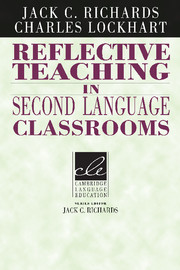Book contents
- Frontmatter
- Contents
- Series editor's preface
- Preface
- Introduction: Teacher development through exploring classroom processes
- 1 Approaches to classroom investigation in teaching
- 2 Exploring teachers' beliefs
- 3 Focus on the learner
- 4 Teacher decision making
- 5 The role of the teacher
- 6 The structure of a language lesson
- 7 Interaction in the second language classroom
- 8 The nature of language learning activities
- 9 Language use in the classroom
- Epilogue
- References
- Index
9 - Language use in the classroom
Published online by Cambridge University Press: 29 January 2010
- Frontmatter
- Contents
- Series editor's preface
- Preface
- Introduction: Teacher development through exploring classroom processes
- 1 Approaches to classroom investigation in teaching
- 2 Exploring teachers' beliefs
- 3 Focus on the learner
- 4 Teacher decision making
- 5 The role of the teacher
- 6 The structure of a language lesson
- 7 Interaction in the second language classroom
- 8 The nature of language learning activities
- 9 Language use in the classroom
- Epilogue
- References
- Index
Summary
One distinguishing feature of language classrooms is that language is usually both the goal of the lesson and the means by which this goal is achieved. The teacher has a number of competing concerns. For example, the teacher plans activities designed to facilitate the learners' acquisition and use of the target language. At the same time, however, the teacher uses the target language as the principal means for giving instructions and directions, modeling target language patterns, and giving feedback on student performance. The students likewise learn language both in order to negotiate classroom interaction with the teacher and other students, and to complete the demands of classroom work. This chapter focuses on the linguistic dimensions of these processes and their effects on the kind of language use that occurs in second and foreign language classrooms. The chapter examines in particular (1) how teachers modify their language, (2) how teachers use questions, (3) how teachers give feedback, and (4) the language of classroom interaction, including the language students use when completing activities.
How teachers modify their language
A major portion of class time in teaching is taken up by teachers talking in front of the class (see Chapter 7). No matter what teaching strategies or methods a teacher uses, it is necessary to give directions, explain activities, clarify the procedures students should use on an activity, and check students' understanding.
A large proportion of the teacher's total communicative efforts can be taken up with coaxing along the communicative process itself, especially when the learners are relative beginners. The teacher has to get the pupils' attention, monitor their understanding by constant checking, clarify, explain, define and when appropriate summarise.
(Ellis 1984: 120)- Type
- Chapter
- Information
- Reflective Teaching in Second Language Classrooms , pp. 182 - 201Publisher: Cambridge University PressPrint publication year: 1994

